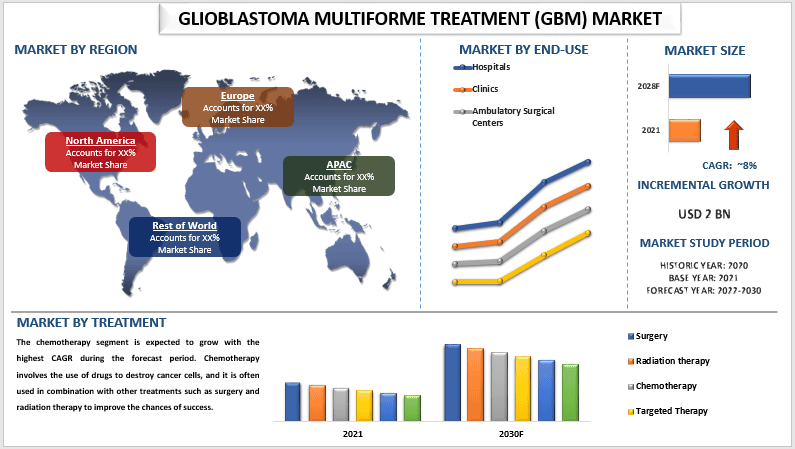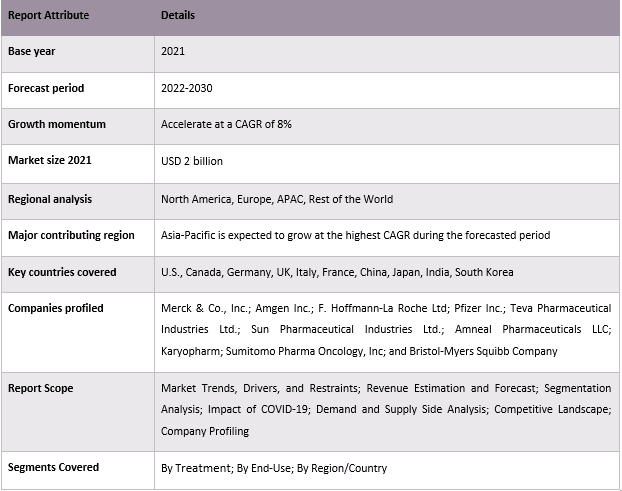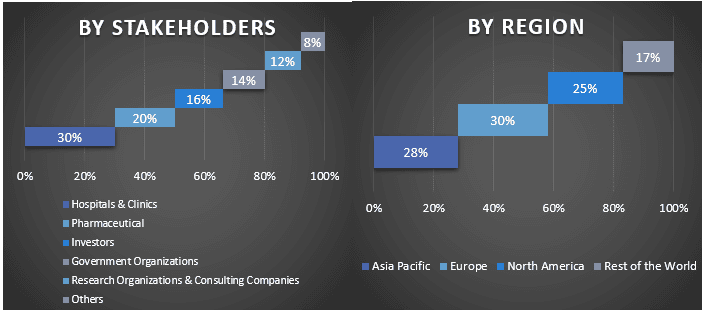- Inicio
- Acerca de nosotros
- Industria
- Servicios
- Leyendo
- Contáctenos
Mercado de tratamiento del glioblastoma multiforme (GBM): Análisis actual y pronóstico (2022-2030)
Énfasis en el tratamiento (cirugía, radioterapia, quimioterapia, terapia dirigida, terapia de campos de tratamiento tumoral (TTF) e inmunoterapia); uso final (hospitales, clínicas, centros quirúrgicos ambulatorios y otros); y región/país

El mercado del tratamiento del glioblastoma multiforme (GBM) se valoró en USD 2 mil millones en 2021 y se espera que crezca a una CAGR del 8% de 2022 a 2030. El mercado del tratamiento del glioblastoma multiforme está experimentando un crecimiento principalmente debido al desarrollo de terapias nuevas e innovadoras para mejorar los resultados de los pacientes. Técnicas como la mutación genética en las células tumorales específicas están ganando popularidad en el tratamiento del glioblastoma multiforme, lo que se atribuye al crecimiento del mercado. Por ejemplo, algunos tumores tienen mutaciones en el gen del receptor del factor de crecimiento epidérmico (EGFR), que pueden ser atacadas con fármacos como gefitinib y erlotinib. Además, el aumento de las aprobaciones de fármacos para el tratamiento del glioblastoma multiforme también es un factor responsable del crecimiento del mercado del tratamiento del glioblastoma. Por ejemplo, en junio de 2022, la FDA aprobó la combinación de dos fármacos dabrafenib y trametinib. Estos agentes entran en la categoría de terapias dirigidas que atacan las células cancerosas que albergan mutaciones BRAF.
Algunos de los principales actores que operan en el mercado son Merck & Co., Inc.; Amgen Inc.; F. Hoffmann-La Roche Ltd; Pfizer Inc.; Teva Pharmaceutical Industries Ltd.; Sun Pharmaceutical Industries Ltd.; Amneal Pharmaceuticals LLC; Karyopharm; Sumitomo Pharma Oncology, Inc; y Bristol-Myers Squibb Company. Estos actores han realizado varias fusiones y adquisiciones junto con asociaciones para facilitar a los clientes productos/tecnologías innovadores y de alta tecnología.
Perspectivas presentadas en el informe
“Entre los tratamientos, se espera que el segmento de la quimioterapia crezca con la CAGR más alta durante el período de pronóstico”.
Según el tratamiento, el mercado se segmenta en cirugía, radioterapia, quimioterapia, terapia dirigida, terapia de campo de tratamiento tumoral (TTF) e inmunoterapia. Se espera que el segmento de la quimioterapia crezca con la CAGR más alta durante el período de pronóstico. La quimioterapia implica el uso de fármacos para destruir las células cancerosas y, a menudo, se utiliza en combinación con otros tratamientos, como la cirugía y la radioterapia, para mejorar las posibilidades de éxito. La creciente incidencia de tumores cerebrales, la creciente demanda de opciones de tratamiento oncológico personalizadas y la creciente adopción de fármacos de quimioterapia avanzados y tecnologías de administración son responsables del crecimiento del segmento.
“Entre el uso final, el segmento de ventas directas mantuvo una participación dominante en 2021”
Según el uso final, el mercado se segmenta en hospitales, clínicas, centros quirúrgicos ambulatorios y otros. El segmento de hospitales mantuvo una participación dominante en 2021. El crecimiento del segmento está impulsado por factores como la creciente incidencia de tumores cerebrales, la creciente demanda de opciones de tratamiento oncológico personalizadas y la creciente adopción de tecnologías avanzadas de diagnóstico y tratamiento. Además, los hospitales cuentan con instalaciones de primer nivel y una gran experiencia en el tratamiento del GBM y otros tipos de cáncer, y trabajan en estrecha colaboración con instituciones académicas y organizaciones de investigación para desarrollar nuevos tratamientos y mejorar los resultados de los pacientes.
“Se espera que Asia Pacífico crezca con el mercado de tratamiento de glioblastoma multiforme (GBM) con la CAGR más alta durante el período de pronóstico”.
Se espera que Asia Pacífico crezca con el mercado de tratamiento de glioblastoma multiforme (GBM) con la CAGR más alta durante el período de pronóstico. Esto se debe principalmente a la presencia de poblaciones grandes y que envejecen rápidamente, y al aumento de la incidencia de tumores cerebrales, incluido el GBM. Por ejemplo, según el Banco Asiático de Desarrollo, para 2050, una de cada cuatro personas en la región de Asia y el Pacífico tendrá más de 60 años. La población anciana (mayores de 60 años) de la región se triplicará entre 2010 y 2050, alcanzando casi 1.300 millones.
Cobertura del informe del mercado de tratamiento del glioblastoma multiforme (GBM)

Razones para comprar este informe:
- El estudio incluye el tamaño del mercado y el análisis de pronóstico validados por expertos clave autenticados de la industria.
- El informe presenta una revisión rápida del desempeño general de la industria de un vistazo.
- El informe cubre un análisis en profundidad de los pares prominentes de la industria con un enfoque principal en las finanzas comerciales clave, las carteras de productos, las estrategias de expansión y los desarrollos recientes.
- Examen detallado de los impulsores, las restricciones, las tendencias clave y las oportunidades que prevalecen en la industria.
- El estudio cubre exhaustivamente el mercado en diferentes segmentos.
- Análisis profundo a nivel regional de la industria.
Opciones de personalización:
El mercado global de tratamiento del glioblastoma multiforme (GBM) se puede personalizar aún más según los requisitos o cualquier otro segmento de mercado. Además de esto, UMI entiende que puede tener sus propias necesidades comerciales, por lo tanto, no dude en conectarse con nosotros para obtener un informe que se adapte completamente a sus requisitos.
Tabla de contenido
Metodología de Investigación para el Análisis del Mercado de Tratamiento de Glioblastoma Multiforme (GBM) (2022-2030)
El análisis del mercado histórico, la estimación del mercado actual y la previsión del mercado futuro del mercado mundial de tratamiento de glioblastoma multiforme (GBM) fueron los tres pasos principales emprendidos para crear y analizar la adopción del tratamiento de glioblastoma multiforme (GBM) en las principales regiones a nivel mundial. Se llevó a cabo una exhaustiva investigación secundaria para recopilar las cifras históricas del mercado y estimar el tamaño actual del mercado. En segundo lugar, para validar estos conocimientos, se tuvieron en cuenta numerosos hallazgos y supuestos. Además, también se realizaron exhaustivas entrevistas primarias con expertos de la industria en toda la cadena de valor del mercado mundial de tratamiento de glioblastoma multiforme (GBM). Tras la suposición y validación de las cifras del mercado a través de entrevistas primarias, empleamos un enfoque de arriba hacia abajo/de abajo hacia arriba para pronosticar el tamaño completo del mercado. Posteriormente, se adoptaron métodos de desglose del mercado y triangulación de datos para estimar y analizar el tamaño del mercado de los segmentos y subsegmentos a los que pertenece la industria. A continuación, se explica la metodología detallada:
Análisis del Tamaño Histórico del Mercado
Paso 1: Estudio Detallado de Fuentes Secundarias:
Se llevó a cabo un estudio secundario detallado para obtener el tamaño histórico del mercado de tratamiento de glioblastoma multiforme (GBM) a través de fuentes internas de la empresa, como informes anuales y estados financieros, presentaciones de rendimiento, comunicados de prensa, etc., y fuentes externas, incluyendo revistas, noticias y artículos, publicaciones gubernamentales, publicaciones de la competencia, informes del sector, bases de datos de terceros y otras publicaciones creíbles.
Paso 2: Segmentación del Mercado:
Después de obtener el tamaño histórico del mercado de tratamiento de glioblastoma multiforme (GBM), llevamos a cabo un análisis secundario detallado para recopilar información histórica del mercado y la cuota de los diferentes segmentos y subsegmentos para las principales regiones. Los principales segmentos incluidos en el informe son el tratamiento y el uso final. Además, se realizaron análisis a nivel de país para evaluar la adopción general de modelos de prueba en esa región.
Paso 3: Análisis de Factores:
Después de adquirir el tamaño histórico del mercado de los diferentes segmentos y subsegmentos, llevamos a cabo un análisis de factores detallado para estimar el tamaño actual del mercado de tratamiento de glioblastoma multiforme (GBM). Además, realizamos un análisis de factores utilizando variables dependientes e independientes, como la intervención y el canal de distribución del mercado de tratamiento de glioblastoma multiforme (GBM). Se llevó a cabo un análisis exhaustivo de los escenarios de demanda y oferta, teniendo en cuenta las principales asociaciones, fusiones y adquisiciones, la expansión empresarial y los lanzamientos de productos en el sector del mercado de tratamiento de glioblastoma multiforme (GBM) en todo el mundo.
Estimación y Previsión del Tamaño Actual del Mercado
Tamaño Actual del Mercado: Basándonos en la información práctica de los 3 pasos anteriores, llegamos al tamaño actual del mercado, los actores clave en el mercado mundial de tratamiento de glioblastoma multiforme (GBM) y las cuotas de mercado de los segmentos. Todos los porcentajes de participación, las divisiones y los desgloses del mercado necesarios se determinaron utilizando el enfoque secundario mencionado anteriormente y se verificaron mediante entrevistas primarias.
Estimación y Previsión: Para la estimación y previsión del mercado, se asignaron ponderaciones a diferentes factores, incluyendo los impulsores y las tendencias, las restricciones y las oportunidades disponibles para las partes interesadas. Después de analizar estos factores, se aplicaron técnicas de previsión relevantes, es decir, el enfoque de arriba hacia abajo/de abajo hacia arriba, para llegar a la previsión del mercado para 2030 para diferentes segmentos y subsegmentos en los principales mercados a nivel mundial. La metodología de investigación adoptada para estimar el tamaño del mercado abarca:
- El tamaño del mercado de la industria, en términos de ingresos (USD) y la tasa de adopción del mercado de tratamiento de glioblastoma multiforme (GBM) en los principales mercados a nivel nacional
- Todos los porcentajes de participación, divisiones y desgloses de los segmentos y subsegmentos del mercado
- Actores clave en el mercado mundial de tratamiento de glioblastoma multiforme (GBM) en términos de productos ofrecidos. Además, las estrategias de crecimiento adoptadas por estos actores para competir en el mercado de rápido crecimiento
Validación del Tamaño y la Cuota del Mercado
Investigación Primaria: Se realizaron entrevistas en profundidad con los líderes de opinión clave (KOLs), incluyendo a los ejecutivos de alto nivel (CXO/VPs, Jefe de Ventas, Jefe de Marketing, Jefe de Operaciones, Jefe Regional, Jefe de País, etc.) en las principales regiones. Los hallazgos de la investigación primaria se resumieron y se realizó un análisis estadístico para demostrar la hipótesis planteada. Los datos de la investigación primaria se consolidaron con los hallazgos secundarios, convirtiendo así la información en conocimientos prácticos.
Distribución de los Participantes Primarios en Diferentes Regiones

Ingeniería del Mercado
Se empleó la técnica de triangulación de datos para completar la estimación general del mercado y para llegar a cifras estadísticas precisas para cada segmento y subsegmento del mercado mundial de Tratamiento de Glioblastoma Multiforme (GBM). Los datos se dividieron en varios segmentos y subsegmentos después de estudiar varios parámetros y tendencias en las áreas de aplicación y usuario final en el mercado mundial de Tratamiento de Glioblastoma Multiforme (GBM).
El objetivo principal del Estudio del Mercado Mundial de Tratamiento de Glioblastoma Multiforme (GBM)
Las tendencias actuales y futuras del mercado mundial de tratamiento de glioblastoma multiforme (GBM) se señalaron en el estudio. Los inversores pueden obtener información estratégica para basar su criterio de inversión en el análisis cualitativo y cuantitativo realizado en el estudio. Las tendencias actuales y futuras del mercado determinaron el atractivo general del mercado a nivel regional, proporcionando una plataforma para que el participante industrial explote el mercado sin explotar para beneficiarse de una ventaja de ser el primero en actuar. Otros objetivos cuantitativos de los estudios incluyen:
- Analizar el tamaño actual y previsto del mercado de tratamiento de glioblastoma multiforme (GBM) en términos de valor (USD). Además, analizar el tamaño actual y previsto del mercado de los diferentes segmentos y subsegmentos
- Los segmentos del estudio incluyen áreas de tratamiento y uso final.
- Definir y analizar el marco regulatorio para la industria del tratamiento de glioblastoma multiforme (GBM)
- Analizar la cadena de valor involucrada con la presencia de varios intermediarios, junto con el análisis de los comportamientos de los clientes y la competencia de la industria
- Analizar el tamaño actual y previsto del mercado de tratamiento de glioblastoma multiforme (GBM) para la principal región
- Los principales países de las regiones estudiadas en el informe incluyen Asia Pacífico, Europa, América del Norte y el resto del mundo
- Perfiles de las empresas del mercado de tratamiento de glioblastoma multiforme (GBM) y las estrategias de crecimiento adoptadas por los actores del mercado para mantenerse en el mercado de rápido crecimiento
- Análisis regional profundo de la industria
Relacionados Informes
Los clientes que compraron este artículo también compraron










